Toys, Play & Activities for Babies and Young Children who have Spinal Muscular Atrophy
Toys, Play & Activities for Babies and Young Children who have Spinal Muscular Atrophy
Play is a child’s main occupation. It is very important for developing gross and fine motor skills, speech, and language. Through play, children learn to explore the world around them. They learn to be imaginative and creative. They learn how to share and negotiate. Play is also important for emotional development, building self esteem and resilience.
We hope this page will:
- give you ideas about how to play with your baby in a way that encourages their development
- help you notice if your baby is not doing what’s expected so that you can ask your clinical team or health visitor for advice
- provide you with suggestions for when they get older.
SMA UK provides two different multisensory toypacks suitable for infants living in the UK who are: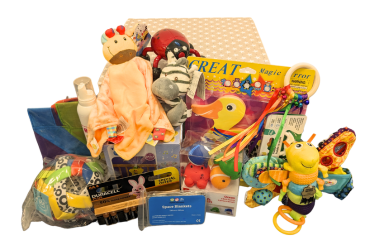
- aged up to 12 months or
- 12 to 24 months of age.
Each family may have one of these packs free of charge.
To request a Multisensory Toy Pack, please contact Support at 01789 267 520 or contact us. Let us know which pack you would like.
To print a copy of this information, open all the drop-down tabs. Or we can send you a printed copy. Contact information@smauk.org.uk
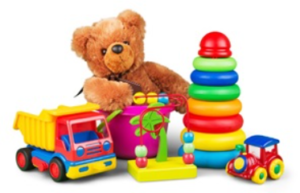 Please always:
Please always:
- Follow the advice you are given by your child’s clinical team about safe and comfortable positions for your baby
- If your child is a ‘tummy breather’, being in some positions may make breathing harder work. If you are not sure if this affects your child check with your physio.
- Follow your physio’s advice on when your child needs to wear their spinal brace, if they have one.
- Read any instructions that come with the toy or activity
- Make sure it is safe and suitable for your child
- Supervise your child when they are playing
- Check toys regularly to make sure they are not broken or unusable
All babies and children develop differently. Concerns about a child with SMA’s ability to sit, stand, and walk are understandable. Their breathing, feeding and swallowing are all as important. So is the development of their understanding, speech, and social skills.
- 4 months
- 8 months
- 1 year
- 18 months
- 2 years
These check-ups should continue until they are at least 4 years old.
Before babies learn how to grasp objects, they respond to things they can look at and listen to. Bright colours or high contrast colours like black and white are easiest to see. Babies particularly like objects that make a noise when moved.
Some Ideas:
- Brightly coloured musical mobiles
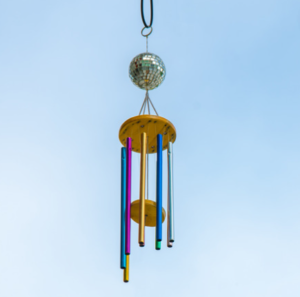
- Baby play gyms and mats
- Talking and singing with your baby
- Music – YouTube and nursery rhymes
- Lullaby projector lightshows
- Bath time fun with music and toys that make a noise or light up
- Wind chimes and coloured ribbons.
As babies develop, they learn to explore using their mouth and by grasping at their toys. Initially they grasp with the palms of their hands. If your baby finds it tiring to use their arms and hands, your physio or OT will advise you how to support your child comfortably and safely. Lying your baby on their side with support may help them to use both their hands together.
Some ideas:
“We play catch indoors with a balloon as this is much lighter than a ball.” Dad of 5-month-old
- Activity centre or play mat
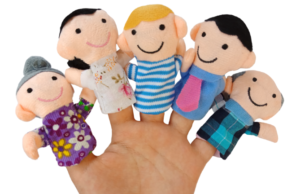
- Lightweight rattles and bells
- Colourful board books with textured pages
- Simple action songs
- Lightweight and colourful finger puppets
- Small soft toys that are easy to hold
- Suitable teething toys.
Over time, your child may start to reach and pull objects towards them and pass them from one hand to the other. Later, your child may begin to pick up small objects between their forefinger and thumb. This is using a ‘pincer’ grasp.
They might enjoy having their toys in front of them on a tray with a rim so that they don’t easily slide off.
Non-slip mats also help to keep toys in place.
Some ideas:
- Building blocks e.g. Duplo. You can also get magnetic blocks/animals which make building easier
- Books with different textures to touch and feel
- Shape sorters
- Stacking cups or rings
As they get older, your child may begin to imitate what they see around them, start to recognise words and the names of familiar objects.
Some ideas:
- Movement and interactive games like peek-a-boo and pat-a-cake
- Toys that move or make a sound
- Hide and seek games with toys
- Storytelling, music or rhyme sessions at your local library
- Swimming or, if you have one, hydrotherapy pool activities. There are various floatation aids available if you need them. Check with your physio, OT or health visitor what would be best for your child
As your child becomes interested in what happens when they do something, you can introduce new toys and ideas to provide fun and learning.
Some ideas:
- Magnetic books, jigsaws or games
- Toys which are operated by a button and make a sound or move
- Playmobil and Duplo figures
- Messy play using sand, water or jelly.
- Drawing or painting. It can help to stick paper down with blue tack to hold it still. Try finger painting, light-touch thicker pencils, felt tip pens or Crayola Twistables which glide on easily. Pencil grips can help.
- Wipeable drawing and doodle boards
- Helping with baking, mixing, and decorating cakes and biscuits
- Throwing and catching games using light sponge balls, larger ones will be easier
- Play food to encourage imaginative play
Working with your child’s current abilities can help avoid them feeling frustrated or upset if they find an activity difficult to manage by themselves.
Some ideas:
- Playdough. Rolling, squeezing, and cutting out shapes.
- Trains and cars on tracks or slides. Magnetic trains are easier to join up
- Magnetic tiles or blocks and fishing games
- Large piece wooden jigsaws and puzzles
- Toys that use the pull of gravity like cars or marbles sent down ramps. This encourages reaching and stretching.
It is important for children to explore, take part in activities and begin to play with their friends more independently.
Your child’s physio or OT will tell you about powered wheelchairs if your child needs one.
Wizzybug is a popular small powered ‘wheelchair’ for children under the age of 5 and weighing up to 20 kgs. With adult supervision it can be used indoors and out and is easy to control. It may be suitable for children as young as 14 months. It is loaned to families free of charge by the charity Designability.
Find out more about Wizzybugs >
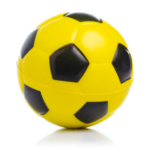 “Soft sponge balls are good for playing football. Our son goes in goal and uses his wheelchair to stop the ball when he is playing with his able-bodied friends.” Dad of 4-year-old
“Soft sponge balls are good for playing football. Our son goes in goal and uses his wheelchair to stop the ball when he is playing with his able-bodied friends.” Dad of 4-year-old
If your child wants to use a computer for games and schoolwork, they may need some adaptations to use it independently. For example, a light touch mouse. Talk to your child’s OT (Occupational Therapist) who will advise you.
Local libraries often run sessions for children and can tell you what’s on offer in your area.
Toy libraries lend out toys at a very low cost.. Your local authority website or your local library should have details of your nearest toy library.
- Smart Play Network > in Scotland, supports toy libraries, play services and play providers.
- Newlife Charity for Disabled Children > – loan toys through their play therapy pod service. Phone: 0800 902 0095.
- Sure Start Centres > provide activities and play ideas for children under the age of 5. See if you have one in your area
- The Portage Scheme > is a national home-visiting educational service for pre-school children with additional support needs and their families.
- Local Children Hospices > offer play facilities, including multi-sensory rooms and music rooms. Some children and families will be eligible for their support.
Specialist suppliers include:
- Dycem > – supply non-slip mats
- Explore your Senses > – sensory toys
- Hope Education > – educational resources
- Liberator > – switch adapted toys
- Living Made Easy > – information about play equipment and suppliers – from the tabs at the top, choose ‘leisure and play’
- Meru > – device holders, sensory and switch-adapted toys
- Rompa > – sensory and developmental toys
- Sense Toys > – sensory toys
- Sensory Toy Warehouse >
- Spacekraft > – sensory resources
- Special Needs Toys > – range of toys
Charity shops, eBay and Facebook Marketplace can be good for buying second-hand toys.
Was this page useful?
 Version 4
Version 4
Author: SMA UK Information Production Team
Last updated: February 2025
Next review : February 2028
Links last checked: February 2025
This page, and its links, provide information. This is meant to support, not replace, clinical and professional care.
Find out more about how we produce our information.
